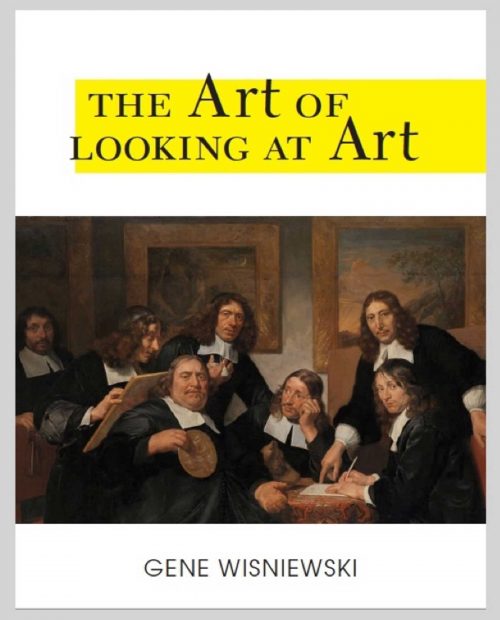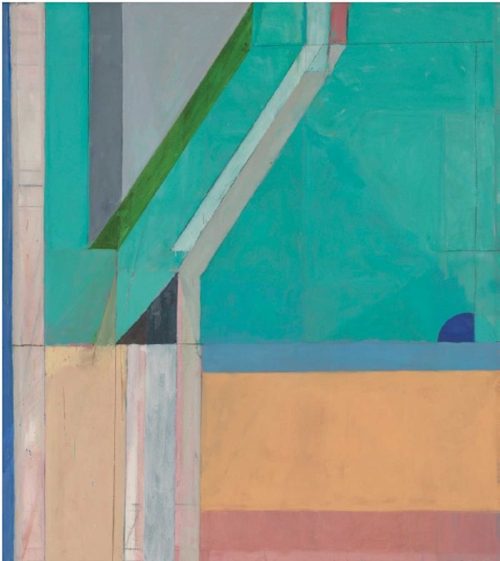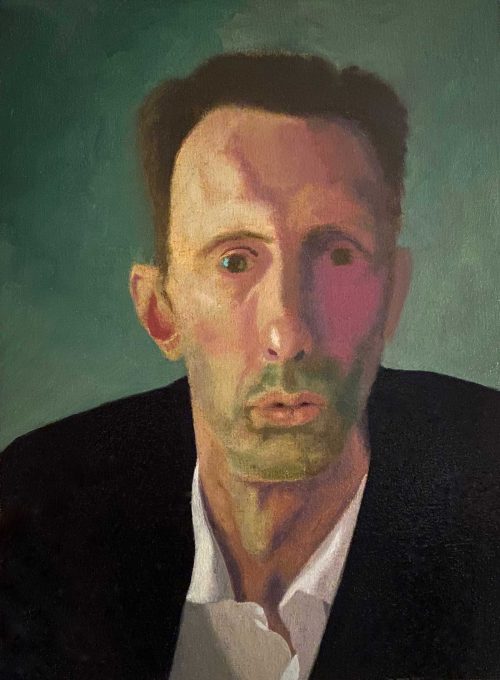
We’ve all had the bewildering experience when visiting an art gallery or museum: “What the hell am I looking at?” Or, “What does this even mean?” Maybe we skip the questions and jump to the cynical conclusions: “I could do that!” Or, “My kid could do that!” We assume that when engaging with art, we should at least be able to recognize what it is we’re looking at. Even more, we expect art to lift us up and to reaffirm our lived experiences. Indeed, the best of visual art doesn’t simply impress us; it inspires us. But it can all too often confound and perplex us as well. Especially since the rise of the avant-garde a century-and-a-half ago, art has become increasingly cryptic to the average viewer. What is one to do?
Thankfully, artist and educator Gene Wisniewski has skillfully responded to our predicament with his new book The Art of Looking at Art. As the title suggests, there is an art to looking at art that we sometimes overlook. The book grew out of Mr. Wisniewski’s Six-Hour Art Major program in New York City. As Polly Weissman, whose children completed the series of classes and lectures, writes in the book’s foreword, “After the first session, my son announced, ‘I want to be an art history major, and I want to take classes from Gene the rest of my life.’ The second class clinched it, and we became groupies.” She goes on to explain how Mr. Wisniewski’s approach is “somewhere between Fearless Leader and Mad Scientist.” The book’s writing itself feels that way, as Fearless Leader/Mad Scientist Wisniewski deftly oscillates between formal erudition and wild-eyed fanatic with the ease of someone thoroughly familiar with and inspired by their subject.
This strategy of reconciling deep knowledge with impassioned reverence distinguishes The Art of Looking at Art from other books with similar aims. Neither a dry tome full of art historical facts, nor a dumbed-down introduction to the subject, Mr. Wisniewski’s book makes the heady material of art history and art theory understandable to all while maintaining a fervent energy. By cleverly coupling his thorough comprehension of art with an engaging and friendly voice, Mr. Wisniewski succeeds in reaching a wide range of readers. Considering today’s increasingly distracted audiences, who are more than ready to flip over to the next diversion if not instantly satisfied, this is no small task.

The 296-page book cites examples of art across time and cultures, but with an emphasis on Western art moving towards modernism, delving into key issues as they arise. Yet, Mr. Wisniewski is careful not to digress or over explain. He touches upon the important themes of art history and art theory without ever becoming boring or repetitive. The Art of Looking at Art is beautifully illustrated with forty-four full-color reproductions depicting some of art history’s most iconic paintings and sculptures, ranging from prehistoric cave paintings to medieval altarpieces, and from Renaissance masterpieces to contemporary art. It’s an ambitious project, but succeeds due to the author’s clear devotion to his subject.
One of the earliest illustrations in the book is of a cave painting from around 35,000 BCE. It depicts various recognizable creatures: rhinos, horses, and oxen, all rendered in an alarmingly modern style. They look like fresh sketches by PIcasso, who after a visit to the Lascaux caves in the Dordogne, following their discovery in 1940, reportedly said to his guide, “They’ve invented everything.” But what about abstract minimalism? Did they invent that too? Of course not. It makes no sense. The aesthetic appreciation for such an art form would require centuries of cultural evolution, culminating in a full flowering of modernity following the Industrial Revolution before anyone would scrutinize such machine-like precision as art.
It’s therefore telling that Mr. Wisniewski concludes his book with a reading of one of Donald Judd’s familiar but confounding stacked wall sculptures. Over the course of thirty years, Judd made numerous of his Stacks; at least one of these appears in any major North American art museum. They’re everywhere. Yet, what are they? In elucidating what appears to be a series of vertically stacked shelves made of Plexiglass and aluminum, Mr. Wisniewski writes:
Mysterious. Severe. Sensuous. Not the words you’d normally use to describe Plexiglass and aluminum. But Donald Judd turned these things into something else––something no one would ever dream of. It’s the same impulse that turned bits of charcoal into herds of wild beasts and hunks of marble into gods. An impulse that’s still with us after sixty thousand years.
That’s pretty inspiring stuff. And, as with Mrs. Weissman’s children, after reading The Art of Looking at Art for a few chapters, you too will become a “groupie.”
While Mr. Wisniewski’s lessons most heavily focus on the Western canon and works by white males, he does touch upon a few key artists of color, female-identifying, and non-Western creators, and the styles and movements for which they forged a path. For example, he dives into the meeting of “high art” and “popular culture,” mostly in the context of “grubby” 1970s New York City through to the city’s gentrification, using general concepts such as graffiti art, rap music, breakdancing, hip-hop, kitsch, the AIDS crisis, and more. Here, he discusses the progression of graffiti writing – from “Cornbread” and TAKI 183 to the work of Jean-Michel Basquiat, and the AIDS epidemic to the work of Kiki Smith and Keith Haring. Throughout the book, he also notes the artistic contributions of a variety of non-white male artists, such as Romare Bearden, the Guerrilla Girls, Pat Steir, Lisa Yuskavage, Ai Weiwei, Long-Bin Chen, Dai Guangyu, among others.
The Art of Looking at Art is geared towards the novice, but the seasoned artist or professional art critic can glean a thing or two by reading it as well. Though we may already know the territory, it’s always good to have a map. We can all get lost at times, even when we think we’re thoroughly familiar with the terrain we’re treading. The Art of Looking at Art provides such a guide for those wishing to learn more about art, and also sheds new light on ideas and themes for the more experienced among us. We can all learn something new by revisiting that which we thought we already knew enough about already. Take a second look and check out The Art of Looking at Art by Gene Wisniewski.
“The Art of Looking at Art” by Gene Wisniewski, published by Rowman & Littlefield Publishers, 2020 (296 pages, ISBN: 9781538133729) is available at Barnes & Noble and Rowman & Littlefield










